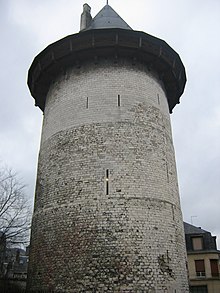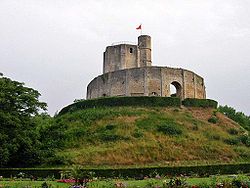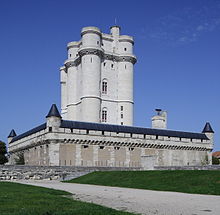Keep: Difference between revisions
No edit summary |
|||
| Line 33: | Line 33: | ||
One of the most famous keeps in [[Europe]] is the celebrated '''[[White Tower (Tower of London)|White Tower]]''' of [[The Tower of London]], constructed by [[William the Conqueror]] in the aftermath of the [[Norman Conquest]]. The cylindrical donjon of [[Rouen]], shown at right, is all that remains of the large city fortress where [[Joan of Arc]] was imprisoned during her trial for heresy. The tallest keep in existence is the donjon of [[Château de Vincennes]] in a suburb of Paris. The title was held previously by the donjon of [[Château de Coucy|Coucy]] in Picardy. |
One of the most famous keeps in [[Europe]] is the celebrated '''[[White Tower (Tower of London)|White Tower]]''' of [[The Tower of London]], constructed by [[William the Conqueror]] in the aftermath of the [[Norman Conquest]]. The cylindrical donjon of [[Rouen]], shown at right, is all that remains of the large city fortress where [[Joan of Arc]] was imprisoned during her trial for heresy. The tallest keep in existence is the donjon of [[Château de Vincennes]] in a suburb of Paris. The title was held previously by the donjon of [[Château de Coucy|Coucy]] in Picardy. |
||
== |
|||
rachels school history == |
|||
== |
|||
==See also== |
==See also== |
||
*[[Japanese_castle#Buildings|]] for ''tenshaku'', the Japanese castle keep |
*[[Japanese_castle#Buildings|]] for ''tenshaku'', the Japanese castle keep |
||
Revision as of 05:52, 17 January 2008



A keep is a strong central tower which is used as a dungeon. Often the keep is the most defended area of a castle, and as such may form the main habitation area, or contain important stores such as the armoury or the main well. An earlier word for a keep, still used for some medieval monuments, especially in France is donjon; a derivative word is dungeon. In Germany, this type of structure is commonly referred to as a bergfried. Keeps come in a remarkable variety of shapes and sizes. They can be of 'square' variety, generally found on the British Isles, cylindrical, octagonal, regular and irregular polygonal forms, or a combination or several of these features. Some castles were effectively, in fact, no more than a keep. Often these are simply referred to as tower houses.
Development
Early keeps were often simply square towers with very thick walls, scarcely more than a residential hall, such as Langeais. This structure later developed into the more recognizable rectangular residential keep by the 11th Century.
The form and function of the keep changed with time and depended on the region. As the keep was a defensive structure, the shaping trend changed to accommodate for the developments in weapon technology. For example, the round or cylindrical keep was first introduced as a defense to the battering ram. A battering ram could cause severe damage to a square tower but would merely glance off the side of a rounded one. Also, a round corner is much harder to successfully undermine than a square one. Rounded towers also have the advantage of less "dead ground", or areas not visible from the tower summit.
By the early 12th Century, cylindrical keeps had become popular, and remained prominent in France until the end of the medieval period (e.g. Montlhéry, Rouen). Variations on the rounded type began to appear at the same time. These included towers with triangular, prow-like projections (like Chateau Gaillard); polygonal keeps such as at Orford or "multi-lobed" keeps like Clifford's Tower.
From the early 13th Century onwards many castles were designed without traditional keeps, instead preferring a plan in which the defences were concentrated in the walls and towers of the enceinte, or in a gatehouse. Early examples can be seen at Boulogne, France and Bolingbroke, Lincolnshire, and later at Conwy Castle, and The Bastille). In some castles the gatehouse took over the functions of the keep, serving as refuge, residence, and command post, such as at Harlech Castle.
As great lords became more interested in grand halls and comfortable living quarters, the keep lost its domestic role. Though keeps continued to be used and built, there is evidence that many had a reduced role, such as lack of residential amenities in the tower plans (latrines, chimneys). In Western Europe, the defensible residential keep experienced a resurgence before the end of the medieval period, as towers were built to securely house great lords and their retinues, at a very high level of comfort and luxury (e.g. Raglan Castle, Ashby-de-la-Zouche, Chateau de Vincennes, Largoët). This type was particularly popular in late medieval Scotland up until the 1600s (e.g. Craigievar Castle). Another word for this type of keep is the tower house.
Notable types
An archetypical form for the keep in the British Isles is the Norman keep, so-called because they were built all across England and Ireland by Norman lords. Norman keeps usually have several distinguishing features in common and the type was very popular during the 11th and 12th Century. Most have towers at each corner, which usually extend above the main keep to form watchtowers. In many cases spiral staircases were contained in or near these corner towers. Another common feature was the forebuilding, which contained the entryway to the keep- its most vulnerable point. This structure extended from the side of the keep, and was often approached by stairs as the entryway was usually above ground level. Sometimes a drawbridge guarded the top of the stairs. Inside, there is usually a central dividing wall that cuts the interior in two parts. The living quarters for the lord or castellan of the castle were usually at the top of the keep, with the great hall(s) below and storage rooms at the bottom. Keeps on this general plan can be seen all across England and Ireland, with many examples in France as well, where they are known by the names donjon carre (square keep) or donjon romain (romanesque keep). Examples include the Tower of London and Rochester Castle in England and Domfront and Loches in France.

A unique form of keep is the shell-keep which essentially a masonry 'fossilization' of a palisade lining the top of a castle defensive mound or motte. In a shell-keep a strong wall was built around the top of the motte, and the domestic buildings were built against it, leaving a round courtyard in the middle. These are different than most keeps in that they are not a tower, but a defensive enclosure, though their purpose as a last refuge, as well as living quarters, is similar. Good examples are Restormel Castle in Cornwall and Gisors Castle in Normandy.
Famous keeps

One of the most famous keeps in Europe is the celebrated White Tower of The Tower of London, constructed by William the Conqueror in the aftermath of the Norman Conquest. The cylindrical donjon of Rouen, shown at right, is all that remains of the large city fortress where Joan of Arc was imprisoned during her trial for heresy. The tallest keep in existence is the donjon of Château de Vincennes in a suburb of Paris. The title was held previously by the donjon of Coucy in Picardy.
See also
- [[Japanese_castle#Buildings|]] for tenshaku, the Japanese castle keep
[[Category:Shelters
rachels school history
[[pt:Torre de menagem
